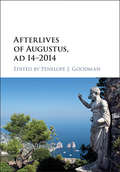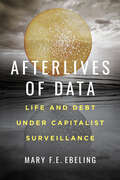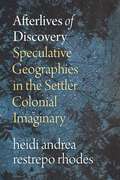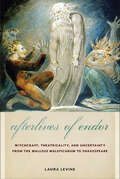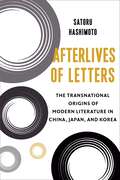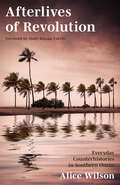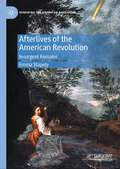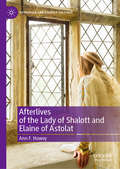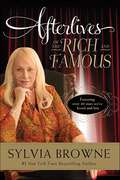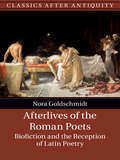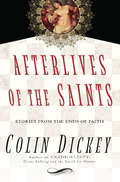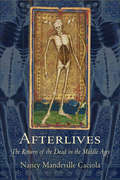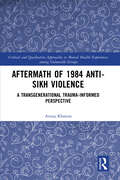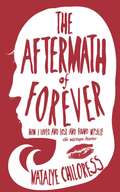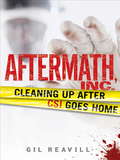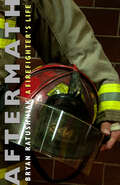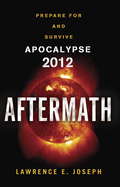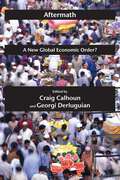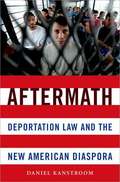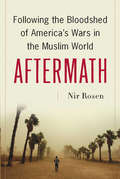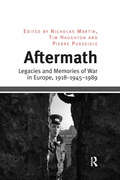- Table View
- List View
Afterlives of Augustus, AD 14–2014
by Penelope J. GoodmanThe bi-millennium of Augustus' death on 19 August 2014 commemorated not only the end of his life but also the beginning of a two-thousand-year reception history. This volume addresses the range and breadth of that history. <P><P>Beginning with the Emperor's death and continuing through Late Antiquity, Early Christianity, the Middle Ages, the Renaissance and early modernity to the present day, chapters address political positioning, religious mythologisation, philosophy, rhetoric, narratives, memory, and material embodiment. As they collectively reveal, Augustus has meant radically different things from one time and place to another, and even to some individual commentators as the circumstances around them changed. The weight of established narratives has often also shaped those of subsequent generations, with or without their conscious awareness. The book outlines and analyses the major themes in Augustus' reception history, clarifying the cultural and historiographical issues at stake and providing a platform for further scholarship.<P> Gives a holistic view of Augustus' reception history from his death to the present day.<P> Demonstrates how much assessments of Augustus have always depended on the values and experiences of the viewer.<P> Uses the post-Classical receptions material at the heart of the book to cast valuable light back on the study of the historical Augustus.
Afterlives of Data: Life and Debt under Capitalist Surveillance
by Mary F.E. EbelingWhat our health data tell American capitalism about our value—and how that controls our lives.Afterlives of Data follows the curious and multiple lives that our data live once they escape our control. Mary F. E. Ebeling's ethnographic investigation shows how information about our health and the debt that we carry becomes biopolitical assets owned by healthcare providers, insurers, commercial data brokers, credit reporting companies, and platforms. By delving into the oceans of data built from everyday medical and debt traumas, Ebeling reveals how data about our lives come to affect our bodies and our life chances and to wholly define us.Investigations into secretive data collection and breaches of privacy by the likes of Cambridge Analytica have piqued concerns among many Americans about exactly what is being done with their data. From credit bureaus and consumer data brokers like Equifax and Experian to the secretive military contractor Palantir, this massive industry has little regulatory oversight for health data and works to actively obscure how it profits from our data. In this book, Ebeling traces the health data—medical information extracted from patients' bodies—that are digitized and repackaged into new data commodities that have afterlives in database lakes and oceans, algorithms, and statistical models used to score patients on their creditworthiness and riskiness. Critical and disturbing, Afterlives of Data examines how Americans' data about their health and their debt are used in the service of marketing and capitalist surveillance.
Afterlives of Discovery: Speculative Geographies in the Settler Colonial Imaginary
by heidi andrea rhodesIn Afterlives of Discovery, heidi andrea restrepo rhodes traces global and national histories as they entangle through the concept and material life of Discovery across Colombia’s evolution into a liberal settler colonial state. Rather than seeing Discovery as a singular event or bygone era, rhodes theorizes Discovery as a globally encompassing, racialized formation of domination and geographic speculation that continues to structure settler colonialism. Discovery’s logics, they argue, are rooted in colonial and capitalist fantasies projected onto the racialized space and place of the colonized other. rhodes draws on critical theory, human rights research, and Colombian archives to challenge dominant narratives that maintain the Colombian armed conflict began as a Marxist insurgency in 1964. Instead, rhodes shows that the conflict is an extension of Discovery’s ongoingness via projects of dispossession, extraction, whitening, and epistemic and political hegemony. Given that Colombia’s national past, present, and future are grounded in Discovery, rhodes asks: How is it possible to build futures that escape Discovery’s grasp?
Afterlives of Endor: Witchcraft, Theatricality, and Uncertainty from the "Malleus Maleficarum" to Shakespeare
by Laura LevineAfterlives of Endor offers an analysis of the way early modern English literature addressed the period's anxieties about witchcraft and theatricality. What determined whether or not a demonologist imagined a trial as a spectacle? What underlying epistemological constraints governed such choices and what conceptions of witchcraft did these choices reveal? Pairing readings of demonological texts with canonical plays and poetry, Laura Levine examines such questions. Through analyses of manuals and pamphlets about the prosecution of witches—including Reginald Scot's skeptical The Discoverie of Witchcraft (1584), King James VI/I's Daemonologie (1597), and Jean Bodin's De la Demonomanie des Sorciers (1580)—Afterlives of Endor examines the way literary texts such as Shakespeare's The Winter's Tale and The Tempest, Spenser's The Faerie Queene, and Marlowe's Tragicall History of Doctor Faustus address anxieties about witchcraft, illusion, and theatricality. Afterlives of Endor attends to the rhetorical tactics, argumentative investments, and underlying tensions of demonological texts with the scrutiny ordinarily reserved for literary texts.
Afterlives of Letters: The Transnational Origins of Modern Literature in China, Japan, and Korea (Studies of the Weatherhead East Asian Institute, Columbia University)
by Satoru HashimotoWhen East Asia opened itself to the world in the nineteenth century, Chinese, Japanese, and Korean intellectuals had shared notions of literature because of the centuries-long cultural exchanges in the region. As modernization profoundly destabilized cultural norms, they ventured to create new literature for the new era.Satoru Hashimoto offers a novel way of understanding the origins of modern literature in a transregional context, drawing on Chinese-, Japanese-, and Korean-language texts in both classical and vernacular forms. He argues that modern literature came into being in East Asia through writerly attempts at reconstructing the present’s historical relationship to the past across the cultural transformations caused by modernization. Hashimoto examines writers’ anachronistic engagement with past cultures deemed obsolete or antithetical to new systems of values, showing that this transnational process was integral to the emergence of modern literature.A groundbreaking cross-cultural excavation of the origins of modern literature in East Asia featuring remarkable linguistic scope, Afterlives of Letters bridges Asian studies and comparative literature and delivers a remapping of world literature.
Afterlives of Revolution: Everyday Counterhistories in Southern Oman
by Alice WilsonThe Dhufar Revolution was fought between 1965–1976, in an attempt to depose Oman's British-backed Sultan and advance social ideals of egalitarianism and gender equality. Dhufar, the southernmost governorate in today's Sultanate, captured global attention for its revolutionaries and their liberation movement's Marxist-inspired social change. But following counterinsurgency victory, Oman's government expunged the revolution from sanctioned historical narratives. Afterlives of Revolution offers a groundbreaking study of the legacies of officially silenced revolutionaries. How do their underlying convictions survive and inspire platforms for progressive politics in the wake of disappointment, defeat, and repression? Alice Wilson considers the "social afterlives" of revolutionary values and networks. Veteran militants have used kinship and daily socializing to reproduce networks of social egalitarianism and commemorate the revolution in unofficial ways. These afterlives revise conventional wartime and postwar histories. They highlight lasting engagement with revolutionary values, the agency of former militants in postwar modernization, and the limitations of government patronage for eliciting conformity. Recognizing that those typically depicted as coopted can still reproduce counterhegemonic values, this book considers a condition all too common across Southwest Asia and North Africa: the experience of defeated revolutionaries living under the authoritarian state they once contested.
Afterlives of the American Revolution: Insurgent Remains (Renewing the American Narrative)
by Emma StapelyThis book challenges the historical common sense that the American Revolution terminated in the birth of the United States. Prevailing narratives of the Revolutionary period rest on the assumption that the war ended with the Treaty of Paris in 1783. Yet from London to Philadelphia, and from the Six Nations’ trans-Appalachian homelands to the shores of Sierra Leone, the decades after the treaty’s signing roil with accounts that disturb the coherence of this chronological division. Insurgent Remains assembles a counter-archive of textual and visual materials—ranging from popular seduction tales and political cartoons to the writings of self-liberated African Americans—that furnishes alternative visions of revolutionary historical experience as an ongoing negotiation with violence and contingency. The book argues that the minor temporalities and political literacies registered in this archive cannot be accommodated by the progressive plot of nationalist history, in which the warfigures as a contest of only two sides (Tory/Whig, British/American, Loyalist/Patriot). Instead, they become legible as “remains”: traces of attachments, modes of collective association, and unresolved struggles that bear insurgent political potential in their own right.
Afterlives of the Lady of Shalott and Elaine of Astolat (Arthurian and Courtly Cultures)
by Ann F. HoweyThis book investigates adaptations of The Lady of Shalott and Elaine of Astolat in Victorian and post-Victorian popular culture to explore their engagement with medievalism, social constructions of gender, and representations of the role of art in society. Although the figure of Elaine first appeared in medieval texts, including Malory’s Le Morte Darthur, Tennyson’s poems about the Lady and Elaine drew unprecedented response from musicians, artists, and other authors, whose adaptations in some cases inspired further adaptations. With chapters on music, art, and literature (including parody, young people’s literature, and historical fiction and fantasy), this book seeks to trace the evolution of these characters and the ways in which they reinforce or challenge conventional gender roles, represent the present’s relationship to the past, and highlight the power of art.
Afterlives of the Rich and Famous
by Sylvia Browne“I have known Sylvia for twenty years, and I have the greatest respect for her….I applaud her for the peace and solace that she has brought to so many.” —Montel WilliamsThe world’s most acclaimed psychic, Sylvia Browne, the New York Times bestselling author of Life on the Other Side, All Pets Go to Heaven, Contacting Your Spirit Guide, and more, returns with a rare and riveting look at the lives of some of our favorite celebrities—after their deaths. How do Elvis Presley, Heath Ledger, John Lennon, and others view their time on Earth? After they have shuffled off this mortal coil, what wisdom do they wish to send back to us? Sylvia Browne’s moving look at these once larger-than-life heroes is a captivating voyage into the secrets they hold beyond the void.
Afterlives of the Roman Poets: Biofiction and the Reception of Latin Poetry (Classics after Antiquity)
by Nora GoldschmidtConscious of ancient modes of reading poetry 'for the life', Roman poets encoded versions of their lives into their texts. The result is a body of literature that cries out to be read in terms of lives in reception. Afterlives of the Roman Poets shows how the fictional biographies (or 'biofictions') of its authors have shaped the reception of Latin poetry. From medieval biographies of Ovid inscribed in the margins of his texts to republican readings of Lucan's death in periods of revolution to the 'death of the author' in Hermann Broch's Der Tod des Vergil, the book tells a cultural history of the reception of ancient literature as imagined through the lens of poets' lives. Putting modern life-writing studies and ancient poetry into dialogue, it brings biofictional reception to debates in classics, and puts antiquity and its reception onto the map of modern studies in life-writing.
Afterlives of the Saints
by Colin DickeyAfterlives of the Saints is a woven gathering of groundbreaking essays that move through Renaissance anatomy and the Sistine Chapel, Borges' "Library of Babel," the history of spontaneous human combustion, the dangers of masturbation, the pleasures of castration, "and so forth" - each essay focusing on the story of a particular (and particularly strange) saint.
Afterlives of the Saints
by Colin DickeyAfterlives of the Saints is a woven gathering of groundbreaking essays that move through Renaissance anatomy and the Sistine Chapel, Borges' "Library of Babel," the history of spontaneous human combustion, the dangers of masturbation, the pleasures of castration, "and so forth" - each essay focusing on the story of a particular (and particularly strange) saint.
Afterlives: The Return of the Dead in the Middle Ages
by Nancy Mandeville CaciolaSimultaneously real and unreal, the dead are people, yet they are not. The society of medieval Europe developed a rich set of imaginative traditions about death and the afterlife, using the dead as a point of entry for thinking about the self, regeneration, and loss. These macabre preoccupations are evident in the widespread popularity of stories about the returned dead, who interacted with the living both as disembodied spirits and as living corpses or revenants. In Afterlives, Nancy Mandeville Caciola explores this extraordinary phenomenon of the living's relationship with the dead in Europe during the five hundred years after the year 1000.Caciola considers both Christian and pagan beliefs, showing how certain traditions survived and evolved over time, and how attitudes both diverged and overlapped through different contexts and social strata. As she shows, the intersection of Christian eschatology with various pagan afterlife imaginings—from the classical paganisms of the Mediterranean to the Germanic, Celtic, Slavic, and Scandinavian paganisms indigenous to northern Europe—brought new cultural values about the dead into the Christian fold as Christianity spread across Europe. Indeed, the Church proved surprisingly open to these influences, absorbing new images of death and afterlife in unpredictable fashion. Over time, however, the persistence of regional cultures and beliefs would be counterbalanced by the effects of an increasingly centralized Church hierarchy. Through it all, one thing remained constant: the deep desire in medieval people to bring together the living and the dead into a single community enduring across the generations.
Aftermath
by Preti TanejaWinner of the 2022 Gordon Burn PrizeShortlisted for 2023 British Book Awards Book of the Year in the Discover category Usman Khan was convicted of terrorism-related offences at age 20, and sent to high-security prison. He was released eight years later, and allowed to travel to London for one day, to attend an event marking the fifth anniversary of a prison education programme he participated in. On 29 November 2019, he sat with others at Fishmongers&’ Hall, some of whom he knew. Then he went to the bathroom to retrieve the things he had hidden there: a fake bomb vest and two knives, which he taped to his wrists. That day, he killed two people: Saskia Jones and Jack Merritt. Preti Taneja taught fiction writing in prison for three years. Merritt oversaw her program; Khan was one of her students. &‘It is the immediate aftermath,&’ Taneja writes. &‘&“I am living at the centre of a wound still fresh.&” The I is not only mine. It belongs to many.&’ In this searching lament by the award-winning author of We That Are Young, Taneja interrogates the language of terror, trauma and grief; the fictions we believe and the voices we exclude. Contending with the pain of unspeakable loss set against public tragedy, she draws on history, memory, and powerful poetic predecessors to reckon with the systemic nature of atrocity. Blurring genre and form, Aftermath is a profound attempt to regain trust after violence and to recapture a politics of hope through a determined dream of abolition.
Aftermath of 1984 Anti-Sikh Violence: A Transgenerational Trauma-informed Perspective (Critical and Qualitative Approaches to Mental Health Experiences among Vulnerable Groups)
by Anuja KhannaThis book explores the inheritance of trauma, distress, and healing from one generation of survivors of the 1984 anti-Sikh violence to the next. It looks at this dyadic relationship and the post-violence context that is marked by their experience of injustice. The book highlights the psycho-social impacts of violence on survivors and their families' everyday struggles against conditions of injustice, marginalization, deprivation, stigma, and threat to one’s individual and collective identity. Through interviews and ethnographic explorations, it analyses the lived experiences of survivors, understanding the everyday struggles of suffering and healing and their relationship with their families and the next generation.This book will be of interest to students, teachers, and researchers of psychology, trauma studies, clinical psychology, health psychology, qualitative research, and social psychology. It will also be useful for those interested in interdisciplinary perspectives on mental health, trauma and disaster mental health, ethnography, and qualitative research methodology.
Aftermath of Banking Crises: Effects on Real and Monetary Variables1
by Poonam GuptaFinancial report from the IMF
Aftermath of Forever: How I Loved and Lost and Found Myself. The Mix Tape Diaries (Punx Ser.)
by Natalye ChildressThe Aftermath of Forever: How I Loved and Lost and Found Myself is a memoir that chronicles the romantic coming-of-age of a woman in her 20s experiencing dating in the San Francisco Bay Area. After the disappointment of a failed marriage, Natalye Childress embarks on a soul-searching journey to discover what happens when the one you thought you would be with forever breaks your heart. Using music as a vehicle to express herself, she revisits ten men from her past and paints a portrait of their relationships through the mixtapes she has made them. Her quest for love takes the form of delving into the hedonistic world of noncommittal beaus, abusive boyfriends, and friends with benefits. She candidly dissects her love life on the page as she shares the inspiring and hopeful moments alongside the awkward and painful realizations that accompany dating in the present day, when everyone is looking for something different. These men, although they leave her life almost as quickly as they entered it, collectively help shape her future as she embarks on a quest not only to find love, but to find herself. Ultimately, she learns the age-old lesson that in order to truly be loved, she needs to first love herself.
Aftermath of the CFA Franc Devaluation
by Jean A.P. Clément Johannes Mueller Stéphane Cossé Jean Le DemFinancial report from the IMF
Aftermath, Inc.
by Gil ReavillNow in paperback, a look into the disturbing but fascinating new field of bio-recovery, as a critically acclaimed crime writer rolls up his sleeves and delves into the world of Aftermath, Inc. The best way to understand the world of Aftermath, Inc. is to imagine life before it. Grief-stricken families of suicide or homicide victims were left to cope on their own. Sometimes police would leave a can of ground coffee behind to soak up the mess. Sometimes local church groups offered to help with the horrific chaos of the scene. Into this void stepped Tim Reifsteck and Chris Wilson, who filled a desperate need by founding their bio-remediation company. Gil Reavill traces their history, introducing us to their clients and employees, and the cops, coroners, and detectives they encounter in their work. Their stories are stranger than fiction, and utterly human and compelling.
Aftermath: A Firefighter's Life
by Bryan Ratushniak“Powerful, honest, & moving.” — Open BookWho doesn’t rush to the window when a fire truck rushes by? Bryan Ratushniak, has spent a thirty-two-year career working on the busiest fire trucks in Canada and has detailed his adventures in this witty memoir. The book details the emotional damage inflicted by the horrors of the job and how the author came out the other side more or less in one piece. Ratushniak shares the ups and downs of balancing home and professional life while trying to hold onto his sanity. Aftermath: A Firefighter’s Life is filled with candid, humorous, tragic, and hopeful stories from behind the “big red doors.”
Aftermath: A Guide to Preparing for and Surviving Apocalypse 2012
by Lawrence E. JosephWhat can we do to mitigate the coming cataclysm? Here Joseph presents the latest findings about the threats to our life on earth including an all-out collapse of power grids and satellite systems resulting from solar flares expected to climax with unprecedented ferocity in 2012. Incipient plagues, famines, droughts and runaway global warming are also assessed for their catastrophic potential. When it comes to formulating a response to an impending apocalypse, the field of options is narrow, but Joseph argues that there is plenty of constructive action that can be taken at the personal, local, national, and global level, individually and collectively, to prepare for, endure and emerge from disaster.
Aftermath: A New Global Economic Order? (Possible Futures)
by Craig Calhoun Georgi DerluguianThe global financial crisis showed deep problems with mainstream economic predictions, as well as the vulnerability of the world's richest countries and the enormous potential of some poorer ones. China, India, Brazil, and other counties are growing faster than Europe or America and have weathered the crisis better. Is their growth due to following conventional economic guidelines or to strong state leadership and sometimes protectionism? These issues are basic to the question of which countries will grow in comind decades, as well as the likely conflicts over global trade policy, currency standards, and economic cooperation.Contributors include: Ha-Joon Chang, Piotr Dutkiewicz, Alexis Habiyaremye, James K. Galbraith, Grzegorz Gorzelak, Jomo Kwame Sundaram, Manuel Montes, Vladimir Popov, Felice Noelle Rodriguez, Dani Rodrik, Saskia Sassen, Luc Soete, and R. Bin Wong.Aftermath is the third part of a trilogy comprised of the first three books in the Possible Future series. Volume 1: Business as UsualVolume 2: The Deepening CrisisVolume 3: AftermathThe three volumes are linked by a common introduction and can be purchased individually or as a set.
Aftermath: Deportation Law and the New American Diaspora
by Daniel KanstroomSince 1996, when new, harsher deportation laws went into effect, the United States has deported millions of noncitizens back to their countries of origin. While the rights of immigrants-with or without legal status--as well as the appropriate pathway to legal status are the subject of much debate, hardly any attention has been paid to what actually happens to deportees once they "pass beyond our aid. " In fact, we have fostered a new diaspora of deportees, many of whom are alone and isolated, with strong ties to their former communities in the United States. Daniel Kanstroom, author of the authoritative history of deportation, Deportation Nation, turns his attention here to the current deportation system of the United States and especially deportation's aftermath: the actual effects on individuals, families, U. S. communities, and the countries that must process and repatriate ever-increasing numbers of U. S. deportees. Few know that once deportees have been expelled to places like Guatemala, Cambodia, Haiti, and El Salvador, many face severe hardship, persecution and, in extreme instances, even death. Addressing a wide range of political, social, and legal issues, Kanstroom considers whether our deportation system "works" in any meaningful sense. He also asks a number of under-examined legal and philosophical questions: What is the relationship between the "rule of law" and the border? Where do rights begin and end? Do (or should) deportees ever have a "right to return"? After demonstrating that deportation in the U. S. remains an anachronistic, ad hoc, legally questionable affair, the book concludes with specific reform proposals for a more humane and rational deportation system.
Aftermath: Following the Bloodshed of America's Wars in the Muslim World
by Nir RosenAs Iraq confronts a bleak and uncertain future and instability spreads throughout the region, an award winning journalist describes the new shape of the Middle East
Aftermath: Legacies and Memories of War in Europe, 1918–1945–1989
by Tim HaughtonFocusing on three of the defining moments of the twentieth century - the end of the two World Wars and the collapse of the Iron Curtain - this volume presents a rich collection of authoritative essays, covering a wide range of thematic, regional, temporal and methodological perspectives. By re-examining the traumatic legacies of the century’s three major conflicts, the volume illuminates a number of recurrent yet differentiated ideas concerning memorialisation, mythologisation, mobilisation, commemoration and confrontation, reconstruction and representation in the aftermath of conflict. The post-conflict relationship between the living and the dead, the contestation of memories and legacies of war in cultural and political discourses, and the significance of generations are key threads binding the collection together. While not claiming to be the definitive study of so vast a subject, the collection nevertheless presents a series of enlightening historical and cultural perspectives from leading scholars in the field, and it pushes back the boundaries of the burgeoning field of the study of legacies and memories of war. Bringing together historians, literary scholars, political scientists and cultural studies experts to discuss the legacies and memories of war in Europe (1918-1945-1989), the collection makes an important contribution to the ongoing interdisciplinary conversation regarding the interwoven legacies of twentieth-century Europe’s three major conflicts.
